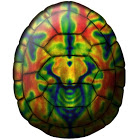The neuroCOMP Project
Extreme fear and anxiety are leading causes of human misery and morbidity, but the underlying mechanisms remain poorly understood. Uncertainty plays a central role in theoretical models of fear and anxiety, but which kind of uncertainty is most important? After all, science and engineering recognize 2 mathematically distinct kinds of uncertainty: Risk and Ambiguity. Which of these is more relevant to threat reactivity and how they map onto the underlying neural circuits is unknown. To address these fundamental questions, we will recruit a racially diverse sample enriched for elevated fear/anxiety symptoms. Using techniques adapted from neuroeconomics, a parametric threat-anticipation paradigm will allow us to simultaneously probe circuits sensitive to categorical and dimensional variation in threat uncertainty for the first time. Smartphone phenotyping will assess real-world threat exposure, uncertainty, and distress.
This project will provide an exciting opportunity to develop one of the first computationally grounded models of fear and anxiety in a relatively large and diverse “DMV” (DC, MD, & VA) sample. It has the potential to resolve on-going theoretical debates, validate a new conceptual approach for use with other read-outs and species, set the stage for new kinds of translational models and clinical studies, and prioritize new targets for therapeutics development.
This project represents a team-science collaboration between the University of Maryland (Drs. Alex Shackman & Jason Smith) and the University of California-Davis (Drs. Andrew Fox & Erie Boorman)
Read more about the project here
The neuroARC Project
Risky drinking is a leading cause of human misery, morbidity, and mortality, and existing treatments are far from curative for many who wish to cut down on their consumption. While the roots of risky drinking are complex, theoretical models of addiction suggest that some misuse alcohol to cope with or reduce anxiety. Yet the factors governing anxiety-fueled risky drinking remain poorly understood.
The neuroARC project will use a combination of techniques—including brain imaging, computational modeling, and smartphone digital phenotyping—in a racially diverse DMV sample to:
- Identify the brain regions and facets of threat uncertainty most relevant to variation in alcohol use, symptoms, and problems
- Pinpoint potentially modifiable psychosocial factors that trigger alcohol craving and consumption
- Determine the neural systems most relevant to anxiety-fueled alcohol consumption in the real world
Building on well-established neuroeconomic models and a fruitful line of psychophysiological research, this study will provide a potentially transformative opportunity to identify new treatment targets, guide the development of new translational models, and inform the development of new digital interventions for risky alcohol consumption.
This project represents a collaboration between the Shackman laboratory and investigators at the University of Wisconsin—Madison (Dr. John Curtin) and University of California, Davis (Drs. Drew Fox and Erie Boorman).
Read more about the project here
The PARANOIA Project
The PARANOIA Project is a NIMH-funded study at the University of Maryland focused on understanding the nature, moderators, and brain bases of paranoia. The project is co-led by Dr. Shackman and Dr. Jack Blanchard. Paranoid ideation—the mistaken belief that intentional harm is likely to occur—spans a continuum, from mild suspicion to persecutory delusions. Among patients with schizophrenia and other psychosis disorders, elevated levels of paranoia are common, debilitating, and challenging to treat. The cues and processes that promote paranoia have grown increasingly clear, but the brain bases of these pathways are unknown, thwarting the development of mechanistic models and, ultimately, the development of more effective or tolerable therapeutics. This project employs a combination of clinical assessments, neuroimaging techniques, sleep actigraphy, and smartphone-based experience sampling to clarify the factors governing paranoia. Leveraging recent methodological advances, the battery of neuroimaging measures include
- ‘Resting’ perfusion (ASL), providing a reliable index of tonic neural activity
- Extended (30+ minutes) movie watching, providing a more reliable assessment of intrinsic functional networks. Among other stimuli, we’re using the 8-minute version of Hitchcock’s Bang You’re Dead from the Cam-CAN Study (also used in the smaller-scale Caltech Conte Center Study). A video overview is available here. Suspense ratings are available here. Recent work from Oli Robinson’s team here
- A hi-def, racially diverse dynamic emotional faces
- A novel uncertain threat anticipation task that leverages aversive and neutral film clips from the Cowen-Keltner database
- An immersive populated/unpopulated cityscapes task
These data will allow us to test the hypothesized contribution of brain circuits responsible for triggering anxiety and evaluating the threat potential of everyday social cues, such as faces. Integrating neuroimaging measures with experience-sampling data will enable us to extend these insights to the real world—a key step to establishing therapeutic relevance—for the first time.
Read more about the project here.
The neuroRED Project 
The neuroRED Project is a recently completed NIMH-funded longitudinal study at the University of Maryland focusing on first-year university students. The purpose of this research project is to understand how emotions are organized in the brain, how they differ from person to person, and ways in which these differences can influence the risk of developing an anxiety disorder or depression. Understanding these processes may clarify why some people develop mental illness and, ultimately, could set the stage for developing better ways of identifying high-risk individuals before they get ill and better treatments for those who do get ill.
The neuroRED project incorporates lab assessments, ecological momentary assessment (EMA), clinical assessments, and fMRI to study neurobehavioral risk in the development of depression and mood disorders.
Read more about the project here.